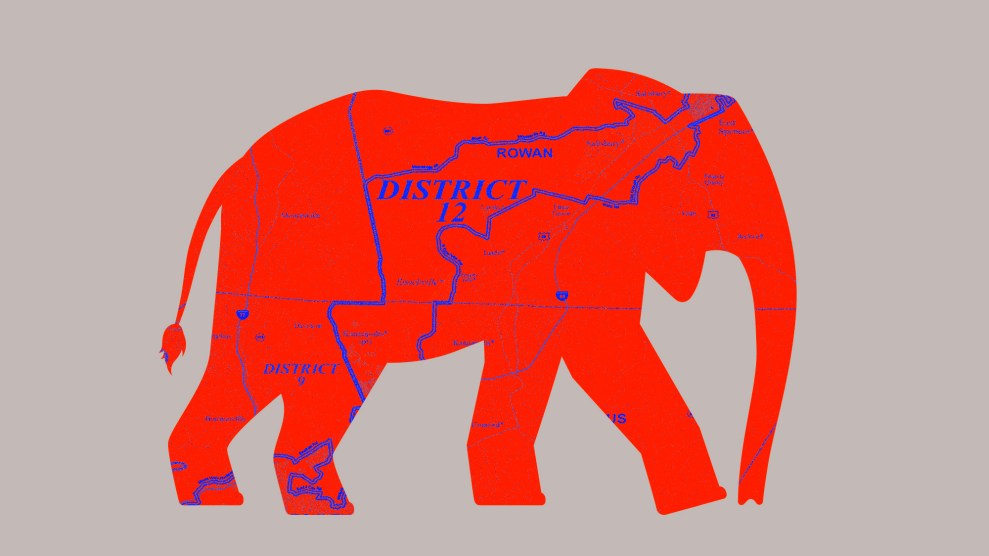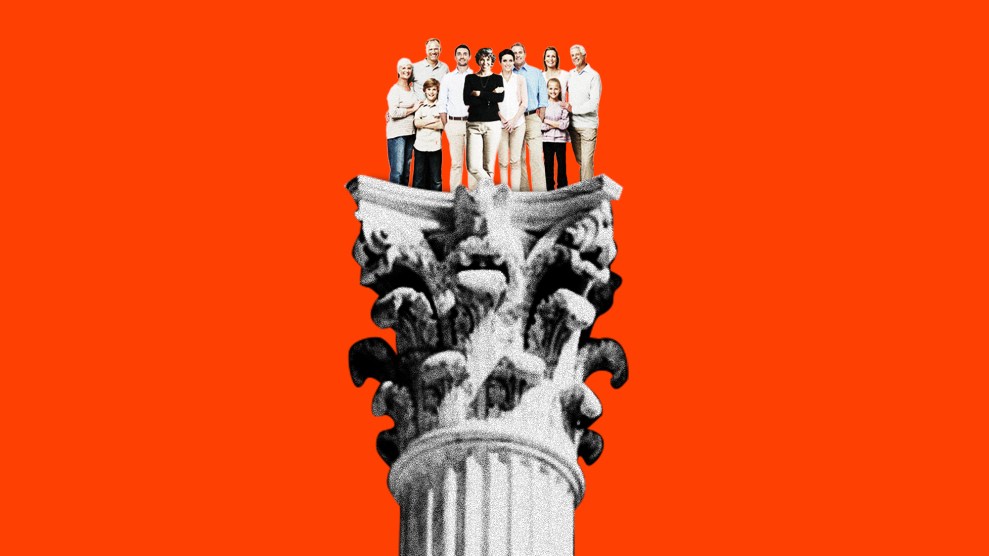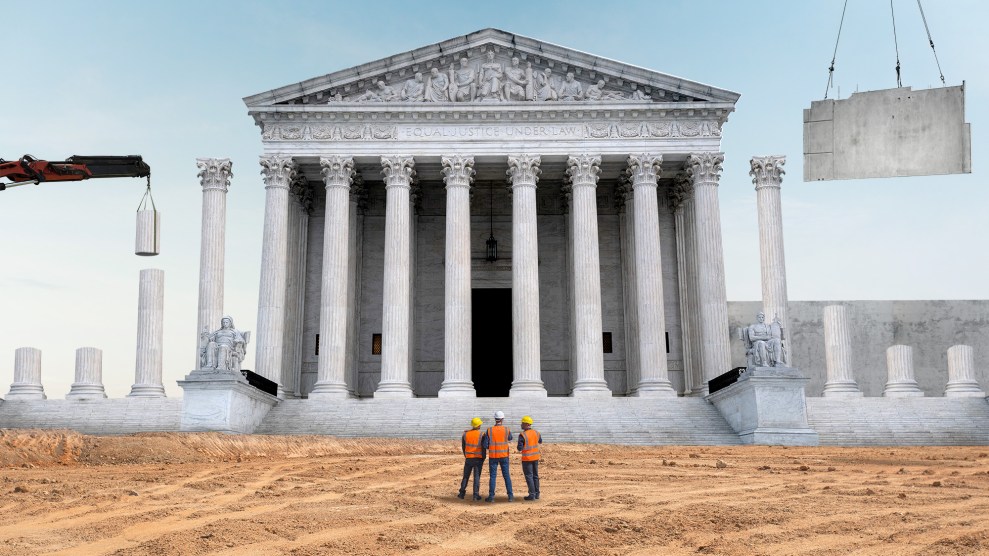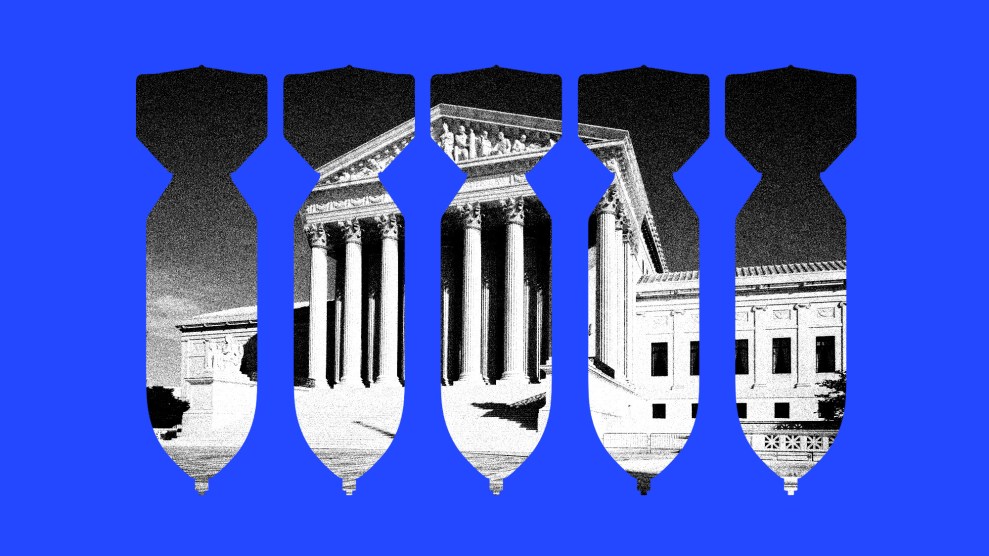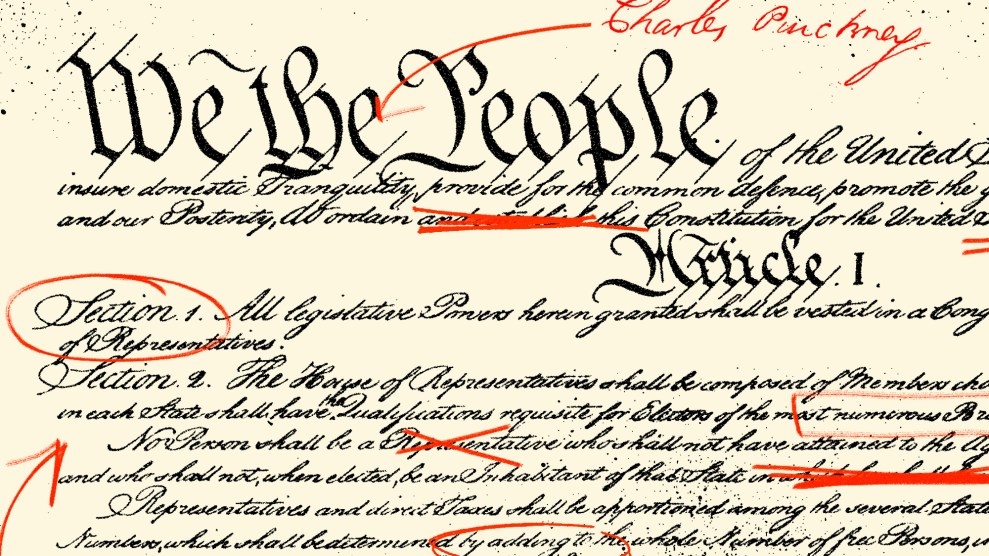
Grace Molteni/Mother Jones; Bettmann/Getty
Three decades after the Constitution was drafted in Philadelphia, Secretary of State John Quincy Adams set about assembling the government’s official Journal of the Convention. Missing from the records was the proposal submitted by Charles Pinckney of South Carolina. So Adams wrote him to request a copy. Pinckney replied with an extraordinary document: a draft that so closely resembled the final Constitution that he would have to have been clairvoyant to have written it.
With most of the 1787 convention’s attendees now dead, Pinckney may have seen an opportunity to claim credit as a key architect of the Constitution. Whatever the reason, Pinckney submitted a fraudulent draft. “At the distance of nearly thirty two Years it is impossible for me now to say which of the 4 or 5 draughts I have was the one,” he replied to Adams’ request in 1818, “but enclosed I send you the one I believe was it.” Oddly, the document was written on paper with a 1797 watermark, matching his accompanying letter. Nonetheless, Adams published it.
The debunkings came fast. James Madison, the convention’s most meticulous notetaker, soon wrote to friends that the draft was inaccurate. Years later, Madison discredited Pinckney’s fraud in writing, explaining the document contained language that had only been arrived at after weeks of debate and could not have been divined before the convention began. Madison, convinced it was a fake, detailed how Pinckney’s supposed draft contradicted a more contemporaneous account of the South Carolinian’s actual proposal. Academics would go on to agree that the plan Pinckney sent was a con. In 1911, when historian Max Farrand compiled his Records of the Federal Convention of 1787, he appended Pinckney’s document with a collection of countervailing evidence, concluding that “it is established beyond all doubt that this draft does not represent ‘Pinckney’s original plan with some additions and modifications.’ It does not even have Pinckney’s original plan as its basis.”
So this August, historians of the Constitution were alarmed to see Pinckney’s fraud credulously cited in a brief submitted to the Supreme Court in Moore v. Harper, a high-stakes case that will be heard on Wednesday and whose outcome could usher in new state-level voter suppression and gerrymandering schemes. If the decision rests on Pickney’s alleged plan or similar shaky foundations, it may also prove to be the most dramatic example of a troubling new trend at the court: the flaunting of inconvenient facts and the adoption of alternative ones in their place.
In recent years, the Republican Party has vigorously questioned reality, as former President Donald Trump and his allies endorsed “alternative facts,” conspiracy theories like QAnon migrated from the fringes to elected members of Congress, and the GOP widely embraced the lie that the 2020 election was stolen. In this environment, the Supreme Court, dominated by Republican-appointed justices, has also recently taken liberties with the facts. The use of a fraudulent document will be a test of how far the court’s conservative majority is willing to go in marshaling alternative facts to suit their agenda.
At stake in Moore v. Harper is a debate over whether the Constitution grants state legislatures virtually unchecked power to regulate federal elections that can only be superseded by Congress. If the court rules in favor of this so-called “independent state legislature” theory, state lawmakers could pass new measures that block voters and create stacked congressional districts without limit from their own state constitutions and courts. The case came about after North Carolina’s Republican-controlled legislature drew an extremely gerrymandered congressional map that the state’s Supreme Court struck down. North Carolina’s Republican legislative leaders then asked the US Supreme Court to uphold their map by advancing the theory, arguing that the state court had no right to review the map. Scholars and election law experts have warned that a ruling for this fringe doctrine would be an offramp from democracy.
The court’s 6-3 conservative majority has repeatedly issued rulings that help the Republican Party win elections, allowing GOP gerrymanders and opening the door to modern voter suppression schemes. The court’s conservative wing has also embraced originalism, a method of constitutional interpretation that purports to enshrine the framers’ original intent, and use it to settle disputes over modern constitutional questions. Increasingly, the conservative justices are embarking on historical excavation to craft rulings that they claim comport with America’s history and tradition. Under this new standard, justices can cast about for examples of laws or practices that fit their ideological goals. But in Moore v. Harper, the court’s partisan leanings and originalist methodology rest in conflict, because there is no evidence that the framers of the Constitution intended to give legislatures such authority over federal elections. Nor is there any record this interpretation was accepted in the republic’s early years. In fact, history shows that the independent state legislature theory is a modern invention, designed to further Republican power.
To get around this inconvenient truth, lawyers representing GOP lawmakers in North Carolina offered up the Pinckney plan as supposed proof. It’s possible that the lawyers at the GOP firm Cooper & Kirk, who cited the version of the document in Farrand’s 1911 compendium, simply failed to read past the plan to the historian’s conclusion that it was a fake, and that they likewise failed to read Madison’s public takedown or his private letters expressing doubts, all of which were included by Farrand. Whether they meant to or not, they hung their argument on a fake document because it offered a glimmer of originalist evidence to back up their case.
The case hinges on what is known as the Constitution’s “Elections Clause,” which states that “The Times, Places and Manner of holding Elections for Senators and Representatives, shall be prescribed in each State by the Legislature thereof.” Pinckney’s plan makes no mention of legislatures, instead giving power over elections to states. The lawyers for the North Carolina Republican lawmakers have seized on that difference to argue that the framers intentionally later added the word “Legislature” in a purposeful move to give state lawmakers exclusive authority over elections: “Crucially,” the lawyers argue, the framers “deliberately changed the Constitution’s language to specify that state legislatures were to exercise that power, not any other state entity and not the State as a whole.”
Two weeks after the North Carolina Republicans filed their brief, Politico magazine published a piece exposing their use of the fraudulent Pinckney plan. “If you’re going to do originalism,” the authors wrote, “at least use originals.” After I read the Politico story, I emailed the lead lawyer for the North Carolina legislators, Cooper & Kirk’s David Thompson, for comment. I asked if he planned to file a correction with the court. He didn’t respond.
A month later, three esteemed law professors and proponents of originalism, including Federalist Society co-founder Steven Calabresi, submitted a friend-of-the-court brief arguing that there is no evidence from the late 18th century to support the independent state legislature theory—including the fake Pinckney plan. “The language Petitioners have trumpeted to this Court is phony,” they wrote, italicizing for emphasis. “This language was no part of the real Pinckney Plan actually presented to the Philadelphia Convention.”
Two days later, another friend-of-the-court brief, this one from law professors and historians of the founding era, spent several pages explaining the real origins of the document and how the other side of the case was attempting to use it. “Petitioners rely on a famously misleading document to create an incorrect drafting history of the Elections Clause,” the brief says. “Petitioners misread that text, which was not part of the drafting history but was written at least a decade after ratification. They thereby construct a false narrative and an invented imputed intent.”
In November, I emailed David Luban, a legal ethics expert at the Georgetown University Law Center to inquire if the lawyers at Cooper & Kirk had an ethical duty to retract their use of the fake Pinckney Plan. “Petitioners’ counsel violated ethics rules,” Luban responded, pointing to a DC Bar ethics rule that says “A lawyer shall not knowingly… fail to correct a false statement of material fact or law previously made to the tribunal by the lawyer.” He added that “Whether Pinckney’s 1818 document was actually his ‘plan’ is very much a material fact—a material fact being a fact that might affect the outcome of the case.”
Shortly thereafter, the lawyers filed a new brief defending their use of the Pinckney plan. They argued that the plan was not technically “a fake” because it is “undisputed” that Pinckney wrote it, and allege that the generations of historians who discredited the document were hoodwinked by Madison’s “campaign to diminish the significance of [Pinckney’s] role at the convention.” While the new brief conceded that the plan Adams published wasn’t written in 1787, it nonetheless clung to the claim that Pinckney’s language was the progenitor of the Elections Clause. “The only real question is whether Pinckney’s original version of the Clause indeed assigned the power to regulate the time and manner of congressional elections to ‘Each State’ generally,” they wrote. Without evidence, they claimed that that lost version “likely” did, setting up their vital claim that the Constitution’s eventual use of the word “legislature” is as a deeply meaningful inclusion. Their analysis ignores a key piece of history about Pinckney’s time in Philadelphia. The argument that the Constitution as ratified invested legislatures with such power relies on Pinckney originally having taken the opposite side. But that wouldn’t be consistent with another position he took, as he actually pushed to empower legislatures by advocating that they, rather than popular elections, should select members of Congress.
The brief is quite a bold retort to its critics: The lawyers claim superior knowledge over historians who specialize in the era, hanging their originalist argument on the thin reed of a long-shot possibility that a plan no one has seen since 1787 contained the words “each state,” and further that these two words played an important role in drafting the Constitution. Luban says the new brief from North Carolina’s lawyers addresses the previous one’s ethical issues, though he hasn’t fact-checked its claims. “It now reads very defensively,” he added. “To avoid outright dishonesty they have made it a much weaker argument.”
In refusing to admit the scale of their error, the lawyers have set up a real test for the high court: will the justices accept the historical consensus, or will they issue a ruling that invents a new history of the Constitution at odds with all other evidence? Not only have three of the conservative justices already endorsed the independent state legislature theory, in the last year, the Republican-appointed majority has repeatedly ignored or misrepresented objective facts in several cases.
In June’s Kennedy v. Bremerton School District, the court took a hammer to the wall separating church and state, when the six conservative justices sided with a public school football coach, Joseph Kennedy, who claimed he was fired for quietly praying alone after the final whistle. “Joseph Kennedy lost his job as a high school football coach because he knelt at midfield after games,” Justice Neil Gorsuch wrote in his majority opinion. “He offered his prayers quietly while his students were otherwise occupied.”
This is not what happened. The record in the case shows that Kennedy’s prayers were neither quiet nor private; students joined in, some because they felt pressured—which is precisely why schools prohibit such prayers. “Kennedy’s practice evolved into postgame talks in which Kennedy would hold aloft student helmets and deliver speeches with ‘overtly religious references,’” Justice Sonia Sotomayor wrote in her dissent, which included a picture showing Kennedy raising a helmet while players kneel around him. When asked to make his prayers private, Kennedy had refused.
Despite the photographic evidence, the conservative justices decided the case on an entirely different set of facts, and the ruling set off bizarre repercussions. While Kennedy’s lawyers had repeatedly claimed to the Supreme Court that Kennedy was fired because of his prayers, and Gorsuch wrote he “lost his job” as a result, that was also a lie. After being put on paid administrative leave for making a spectacle of his prayers, he chose not to reapply for a renewal of his one-year contract. The district didn’t rehire him because, at least in part, he had not asked to be. As a piece in the Seattle Times put it, the court’s order put the school district in the strange situation of having “to reinstate someone who didn’t apply for the job then and doesn’t appear eager for it now.”
Recent high court rulings premised on false facts have led to more serious consequences. Last term, an opinion by Justice Clarence Thomas made a critical factual error that could lead to two people being executed. In that case, Shinn v. Ramirez, two Arizona death row inmates sought to overturn their sentences by arguing they had ineffective representation. In May, the court’s six GOP-appointed justices ruled that they could not introduce new evidence about their lawyers shortcomings, making it much more difficult for them to prevail. But the opinion made their task even harder by introducing a factual error: that the inmates conceded they would lose on the evidence developed in state court.
Shortly after the opinion was released, attorney Robert Loeb, who had argued the inmates’ case, filed a motion asking the justices to delete the relevant sentence from the final opinion. In June, the state of Arizona agreed, and joined the prisoners’ lawyer in asking the court to replace the inaccurate sentence with a corrected one. Within weeks the court denied the request, without explanation. The takeaway: Two men—one who might be innocent and one who has a severe mental disability—have had their chances at escaping execution dimmed by a justice’s factual error, and the Supreme Court is apparently fine with allowing that inaccuracy to stand, haunting further efforts to save their lives.
Leah Litman, a professor at the University of Michigan’s law school, says these inaccuracies, taken together, “are suggestive of a court that is reaching for facts in service of a conclusion rather than looking at the facts and trying to figure out what the facts are before reaching a conclusion.”
Originalism, and its reliance on the laws and mores of 18th and 19th centuries to determine modern law inevitably imposes the views of the white men who once ruled over what is now a pluralistic democracy. The practice also encourages selective fact-finding, with the court’s justices getting historical claims filtered down through friend-of-the-court briefs filed by advocates pushing an agenda. And, in some of the court’s most high-profile decisions, the justices have used them to invent their own historical narratives that fit their goals. After two major rulings were handed down in June, one gutting gun regulation and the other overturning Roe v. Wade, historians criticized the court for selecting their own facts and ignoring significant contrary evidence to create inaccurate histories of both gun and abortion regulation.
How much bolder would it be to rewrite the history of the constitutional convention to invest local partisan officials with unprecedented power over elections, and in so doing, elevate a bit player in the country’s founding? It would be a true irony of originalism if, in Moore v. Harper, it led the court not to invoke the words of esteemed framers like James Madison but to discredit them. After more than two centuries, Pinckney’s con could finally pan out.

